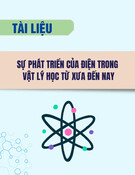Magnetic Fields
Analysis Model: Particle in a Magnetic Field q In our study of electricity, we described the interactions between charged objects in terms of electric fields. Recall that an electric field surrounds any electric charge. In addition to containing an electric field, the region of space surrounding any moving electric charge also contains a magnetic field. A magnetic field also surrounds a magnetic substance making up a permanent magnet.
Magnetic Field Lines
q Magnetic filed lines outside the magnet point away from the north pole and toward the south pole.
Magnetic Force
q The existence of a magnetic field at some point in
space can be determined by measuring the magnetic force F exerted on an appropriate test particle placed at that point.
q If we perform an experiment by placing a particle with
charge q in the magnetic field
Magnetic Force
q The magnetic field is defined in terms of the force
acting on a moving charged particle
q The magnitude of the magnetic force on a charged
particle is
Electric Field vs Magnetic Field
q SI unit of magnetic field is tesla (T)
An Electron Moving in a Magnetic Field q An electron in an old-style television picture tube
moves toward the front of the tube with a speed of 8.0 x 106 m/s along the x axis (Fig. 29.6). Surrounding the neck of the tube are coils of wire that create a magnetic field of magnitude 0.025 T, directed at an angle of 60° to the x axis and lying in the xy plane. Calculate the magnetic force on the electron.
An Electron Moving in a Magnetic Field
Representations of Magnetic Field Lines Perpendicular to the Page
Motion of a Charged Particle in a Uniform Magnetic Field q The magnetic force on the particle is perpendicular to both the magnetic field lines and the velocity of the particle.
q The particle changes the direction of
its velocity in response to the magnetic force, whereas the magnetic force remains perpendicular to the velocity.
q If the force is always perpendicular to the velocity, the path of the particle is a circle!
q The particle in uniform circular motion
model!
Motion of a Charged Particle in a Uniform Magnetic Field
q Newton 2nd Law:
q The particle moves in a circle, we
also model it as a particle in uniform circular motion
q The radius of the circular path:
q The angular speed of the particle:
Counterclockwise for a positive charge Clockwise for negative charge
The Path of Charged Particle in a Uniform Magnetic Field is a Helix
q Because ax = 0 (in moving direction); vx is constant;
q the magnetic force
causes the components vy and vz to change in time. And hence the motion is a helix whose axis is parallel to the magnetic field
q The projection of the path onto the yz plane (viewed along x axis) is a circle.
Motion of a Charged Particle in a Non- Uniform Magnetic Field
Magnetic Force Acting on a Current- Carrying Conductor
q The current is a collection of many charged particles in motion; hence, the resultant force exerted by the field on the wire is the vector sum of the individual forces exerted on all the charged particles making up the current.
q The force exerted on the
particles is transmitted to the wire when the particles collide with the atoms making up the wire.
Magnetic Force Acting on a Current- Carrying Conductor
q The magnetic force exerted on a
charge q moving with a drift velocity is
q The total magnetic force on the segment of wire of length L is
• L: wire length • A: cross-sectional area • n: number of mobile charge carriers
Magnetic Force Acting on a Current- Carrying Conductor
q For an arbitrarily shaped wire segment of uniform cross section in a magnetic field. The force exerted on a small segment of vector length ds is
q The total force acting on wire is the integral over the length of the wire:
a and b represent the endpoints of the wire.
Force on a Semicircular Conductor qA wire bent into a semicircle of radius R forms a
closed circuit and carries a current I. The wire lies in the xy plane, and a uniform magnetic field is directed along the positive y axis as in Figure. Find the magnitude and direction of the magnetic force acting on the straight portion of the wire and on the curved portion.
Force on a Semicircular Conductor Using the right-hand rule for cross products, we see that the force F1 on the straight portion of the wire is out of the page and the force F2 on the curved portion is into the page. Is F2 larger in magnitude than F1 because the length of the curved portion is longer than that of the straight portion?
Torque on a Current Loop in a Uniform Magnetic Field
q Consider a rectangular loop carrying a current I in the
q No magnetic forces act on sides (1) and (3) because these wires are parallel to the field
q Magnetic forces act on
sides (2) and (4) because these sides are oriented perpendicular to the field.
presence of a uniform magnetic field directed parallel to the plane of the loop as shown in Figure.
Torque on a Current Loop in a Uniform Magnetic Field
q If the loop is pivoted so that it can rotate about point O, a
torque that rotates clockwise. The magnitude of this torque
where the moment arm about O is b/2 for each force.
q The maximum torque can be written as
This maximum-torque result is valid only when the magnetic field is parallel to the plane of the loop.
Area enclosed by the loop is A = ab
Torque on a Current Loop in a Uniform Magnetic Field q Supposing the uniform magnetic field makes angle θ < 90° q Assuming B is perpendicular to sides (2) and (4) q Magnetic forces F1 and F3 exerted on sides (1) and (3)
cancel out.
q Magnetic forces F2 and F4 exerted on sides (2) and (4)
produce a torque about any point.
F2 = (b/2)sinθ F4 = (b/2)sinθ F2 = F4 = IaB
Vector Form of Torque
q Torque exerted on a loop placed in uniform magnetic field B is
q IA is defined to be magnetic dipole moment μ (or simply “magnetic moment”), and is
q If a coil of wire contain N loops of the same area, the
magnetic moment of the coil is
q The torque exerted on a current-carrying loop in a magnetic
field B as
q c.f. the torque exerted on an electric dipole
Potential Energy of a Magnetic Dipole in Magnetic Field
q Recall the potential energy of an electric dipole in electric
(this energy depends on the orientation of the dipole in the electric field)
field is
q Similarly, the potential energy of a system of a magnetic
dipole in a magnetic field depends on the orientation of the dipole in the magnetic field
Potential Energy of a Magnetic Dipole in Magnetic Field q The potential energy of a system of a magnetic dipole in a
magnetic field is
q The potential energy has its lowest energy Umin = -μB when μ points in the same direction as B
q The potential energy has its
highest energy Umin = +μB when μ points in the same direction as B
The Magnetic Dipole Moment in a Coil q A rectangular coil of dimensions 5.40 x 8.50 cm consists of 25 turns of wire and carries a current of 15.0 mA. A 0.350-T magnetic field is applied parallel to the plane of the coil. (A) Calculate the magnitude of the magnetic dipole moment of
the coil
(B) What is the magnitude of the torque acting on the loop?
The Magnetic Dipole Moment in a Coil q A rectangular coil of dimensions 5.40 x 8.50 cm consists of 25 turns of wire and carries a current of 15.0 mA. A 0.350-T magnetic field is applied parallel to the plane of the coil. (A) Calculate the magnitude of the magnetic dipole moment of
the coil
(B) What is the magnitude of the torque acting on the loop?
Currents Create Magnetic Fields q 1820: Oersted did an experiment à a magnetic compass is deflected by current à magnetic field are due to currents
Why do the un-magnetized filings line up with the field?
In fact, currents are the only way to create magnetic fields.
The Biot-Savart Law q The Biot–Savart law describes the magnetic field generated
by a constant electric current
q The Biot–Savart law is fundamental to magnetostatics,
playing a role similar to that of Coulomb’s law in electrostatics
q The magnetic field produced by the
current in the wire
μ0 is a constant called the permeability of free space
The Biot-Savart Law q The total magnetic field B is a sum up contributions from all current elements Ids that make up the current is an integral
Special care for the integrand of cross product
q The integral is taken over the entire current distribution.
q The magnitude of the magnetic field is inversely proportional
to the square of the distance r (similar to electric field).
q Direction of electric field is
radial
q Direction of magnetic field is perpendicular to length ds and unit vector r-hat
Direction of Currents/Magnetic Fields For a straight wire the magnetic field lines are circles wrapped around it. Another Right Hand Rule shows the direction:
)
q
dB
=
sin( ids 2
µ 4
0 p
r
Magnetic Field Surrounding a Thin, Straight Conductor
q Consider a thin, straight wire of finite length carrying a
constant current I and placed along the x axis as shown in Figure 30.3. Determine the magnitude and direction of the magnetic field at point P due to this current.
Magnetic Field Surrounding a Thin, Straight Conductor
q Consider a thin, straight wire of finite length carrying a
constant current I and placed along the x axis as shown in Figure 30.3. Determine the magnitude and direction of the magnetic field at point P due to this current.
Magnetic Field Surrounding a Thin, Straight Conductor
q If the wire becomes infinitely long, we see that θ1 = π/2 and θ2 = -π/2 and hence (sinθ1 – sinθ2) = [sin π/2 – sin(-π/2)] = 2
Magnetic Field due to a Curved Wire Segment
q Calculate the magnetic field at point O for the current- carrying wire segment shown in Figure 30.4. The wire consists of two straight portions and a circular arc of radius a, which subtends an angle θ.
Magnetic Field due to a Curved Wire Segment
q Calculate the magnetic field at point O for the current- carrying wire segment shown in Figure 30.4. The wire consists of two straight portions and a circular arc of radius a, which subtends an angle θ.
Magnetic Field on the Axis of a Circular Current Loop q Consider a circular wire loop of radius a located in the yz plane and carrying a steady current I as in Figure 30.5. Calculate the magnetic field at an axial point P a distance x from the center of the loop.
Magnetic Field on the Axis of a Circular Current Loop q Consider a circular wire loop of radius a located in the yz plane and carrying a steady current I as in Figure 30.5. Calculate the magnetic field at an axial point P a distance x from the center of the loop.
Magnetic Field on the Axis of a Circular Current Loop q What if we consider points on the x axis very far from the loop? How does the magnetic field behave at these distant points?
q x >> a, we can neglect the term a2 in the denominator
The magnetic Force Between to Parallel Conductors
q The magnetic force on a length l of wire 1
q l is perpendicular to B2, the magnitude of
F1 is
q The direction of F1 is toward to wire 2 because l x B is in
that direction.
The magnitude of force per unit length
Ampère’s Law q When the magnitude of the force per unit length between two
enc
i µ= 0
ienc= net current passing through the loop
! ! ò sdB "
long, parallel wires that carry identical currents and are separated by 1 m is 2 x 1027 N/m, the current in each wire is defined to be 1 A. • Line Integral over an “Amperian loop” - a closed path. • Adds up components of B along the loop path. • All paths that enclose a certain set of currents have same result.
Picture for applications:
• Only the tangential component of B
along ds contributes to the dot product • Current outside the loop (i3) creates field but contributions to the path integral cancel around closed path.
Another version of RH rule:
- curl fingers along Amperian loop - thumb shows + direction for net current
Magnetic Field Created by a Long Current- Carrying Wire A long, straight wire of radius R carries a steady current I that is uniformly distributed through the cross section of the wire (Fig. 30.13). Calculate the magnetic field a distance r from the center of the wire in the regions r < R and r > R.
Magnetic Field Created by a Long Current- Carrying Wire A long, straight wire of radius R carries a steady current I that is uniformly distributed through the cross section of the wire (Fig. 30.13). Calculate the magnetic field a distance r from the center of the wire in the regions r < R and r > R.
Magnetic Field Created by a Long Current- Carrying Wire A long, straight wire of radius R carries a steady current I that is uniformly distributed through the cross section of the wire (Fig. 30.13). Calculate the magnetic field a distance r from the center of the wire in the regions r < R and r > R.
(The current I’ passing through the plane of circle 2 is less than the total current I)
Magnetic Field Created by a Long Current- Carrying Wire
Magnetic Field Created by a Toroid q A device called a toroid (Fig. 30.15) is often used to create
an almost uniform magnetic field in some enclosed area. The device consists of a conducting wire wrapped around a ring (a torus) made of a non-conducting material. For a toroid having N closely spaced turns of wire, calculate the magnetic field in the region occupied by the torus, a distance r from the center.
Magnetic Field Created by a Toroid q A device called a toroid (Fig. 30.15) is often used to create
an almost uniform magnetic field in some enclosed area. The device consists of a conducting wire wrapped around a ring (a torus) made of a non-conducting material. For a toroid having N closely spaced turns of wire, calculate the magnetic field in the region occupied by the torus, a distance r from the center.
q Ampère’s Law for loop 1:
Magnetic Field of a Solenoid q A solenoid is a long wire wound in the form of a helix à to create a reasonably uniform magnetic field in the space surrounded by turns of wire
Magnetic Field of a Solenoid
q B in the interior space is uniform and parallel to the axis and the magnetic field lines in the exterior space form circles around the solenoid.
q Apply Ampère’s law to the dash rectangular
path (loop 2) of length l and width w to evaluate the integral B·ds over each side of the rectangle. Contributions from side 2 and side 4 are zero
N is number of turns in the length l N I is total current through rectangle
Magnetic Flux q The total magnetic flux !B through the surface of area A is
q The total magnetic flux !B is then
q θ = 90° (B is perpendicular to A), !B is
zero
q θ = 0° (B is parallel to A), !B is
maximum
Magnetic Flux through a Rectangular Loop q A rectangular loop of width a and length b is located near a long wire carrying a current I (Fig. 30.21). The distance between the wire and the closest side of the loop is c. The wire is parallel to the long side of the loop. Find the total magnetic flux through the loop due to the current in the wire.
Magnetic Flux through a Rectangular Loop q A rectangular loop of width a and length b is located near a long wire carrying a current I (Fig. 30.21). The distance between the wire and the closest side of the loop is c. The wire is parallel to the long side of the loop. Find the total magnetic flux through the loop due to the current in the wire.
Gauss’s Law in Magnetism q The net magnetic flux through any closed surface is always
zero:
Gauss’s Law in Magnetism q The net magnetic flux through any closed surface is always
zero:
Faraday’s Law of Induction
q When a magnet is moved toward the loop, the reading on the
ammeter changes from zero to a nonzero value, arbitrarily shown as negative in Figure 31.1a. When the magnet is brought to rest and held stationary relative to the loop (Fig. 31.1b), a reading of zero is observed. When the magnet is moved away from the loop, the reading on the ammeter changes to a positive value as shown in Figure 31.1c. Finally, when the magnet is held stationary and the loop
q The current is induced current and it is said that it is produced by an induced electromagnetic force (emf)
Faraday’s Law of Induction
q The emf is directly proportional to the time rate of the change of the magnetic flux through the loop.
q Faraday’s law of induction:
q If a coil consists of N loops:
q For a loop enclosing an area A lies
in uniform magnetic field B
Inducing an emf in a Coil q A coil consists of 200 turns of wire. Each turn is a square of
side d = 18 cm, and a uniform magnetic field directed perpendicular to the plane of the coil is turned on. If the field changes linearly from 0 to 0.50 T in 0.80 s, what is the magnitude of the induced emf in the coil while the field is changing?
Inducing an emf in a Coil q A coil consists of 200 turns of wire. Each turn is a square of
side d = 18 cm, and a uniform magnetic field directed perpendicular to the plane of the coil is turned on. If the field changes linearly from 0 to 0.50 T in 0.80 s, what is the magnitude of the induced emf in the coil while the field is changing?
Lenz’s Law
q Lenz’s Law:
i.e., the induced current tends to keep the original magnetic flux through the loop from changing.
The induced current in a loop is in the direction that creates a magnetic field that opposes the change in magnetic flux through the area enclosed by the loop.

![Bài giảng Vật lý đại cương và sinh lý [mới nhất]](https://cdn.tailieu.vn/images/document/thumbnail/2025/20250804/vijiraiya/135x160/88621754292979.jpg)


















![Bộ câu hỏi lý thuyết Vật lý đại cương 2 [chuẩn nhất/mới nhất]](https://cdn.tailieu.vn/images/document/thumbnail/2025/20251003/kimphuong1001/135x160/74511759476041.jpg)
![Bài giảng Vật lý đại cương Chương 4 Học viện Kỹ thuật mật mã [Chuẩn SEO]](https://cdn.tailieu.vn/images/document/thumbnail/2025/20250925/kimphuong1001/135x160/46461758790667.jpg)




